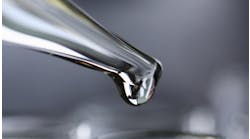“A well-oiled machine” has become a synonym for efficiency. But what does it mean for a machine to be well-oiled?
Proper lubrication is an ongoing maintenance challenge in pretty much every food and beverage plant. It’s especially intense in plants with thousands of lubrication points for equipment that runs for two or three shifts per day. Getting the right kinds of oil and grease, in the right amounts, to those points consistently, is one of the most important tasks facing a maintenance team.
One of the biggest pitfalls is over-lubrication. The immediate problem is that equipment with excessive lubrication can start dripping, or even flinging, the excess where it’s not supposed to go, including into the food product. Although food-grade lubricants are formulated so that consumption of trace amounts is harmless, they’re rated only for “incidental contact” of about 10 parts per million, says Scott Besedick, district manager at Lubriplate.
“So you really don’t want to touch the food product with even H1 food-grade grease or oil,” Besedick says. “Therefore, using the correct amount is paramount to running a good, clean, safe program.”
Excessive lubrication can also harm the equipment itself, especially when it runs at high speeds. “If you’re lubricating a bearing that’s supposed to have only an ounce of grease in it, and you put two ounces of grease in it, it creates internal friction,” Besedick says. The balls in the bearing can’t roll freely and skid, which creates friction and heat.
“Over-greasing of bearings is a serious problem. ‘If a single shot of grease is good, then two shots must be better, right?’” says Benjamin Garmier, vice president of Renewable Lubricants Inc. “This thought pattern has worn out many seals, as blasting the added grease leads to premature seal failure.”
High-speed equipment, such as fans, are especially susceptible to over-lubrication, Garmier says. “If you get a little wobble in a high-speed fan you’re going to notice it in the bearing. Training can certainly help with getting the proper type and amount of grease into the fitting.”
It sometimes can be difficult to determine when over-lubrication is taking place. It’s more obvious with grease, which is heavier than oil and usually opaque; it can be seen dripping out of a bearing housing or other lube point. But food-grade oils are usually clear, making them harder to detect, especially in areas with heavy water usage. “You might be in an environment with a lot of water, so it’s hard to distinguish sometimes,” Besedick says.
Most lubrication is done according to a preset schedule, usually one suggested by the equipment manufacturer. That should serve at least as a starting point. By analyzing samples of the lubricant after the recommended service interval, a maintenance team can determine whether the intervals can be extended. This is especially important with synthetic lubricants, which are more expensive precisely because they’re more durable. “The longer intervals are what you are paying for,” Garmier says.
Running into danger
Another potential pitfall for lubrication is the danger involved in servicing equipment that’s still running. Lubrication that takes place while everything is stopped, for instance after washdowns, is relatively easy. But many kinds of equipment have to be lubricated while running due to the length or intensity of their operations, creating a hazard for personnel.
That’s why an increasing number of equipment manufacturers are including automatic lubrication systems with their equipment, says Jeff Seymour, a district manager with Lubriplate. This is especially true for European manufacturers, and Lubriplate is starting to see more American companies go in that direction.
In part, it’s a staffing situation, Seymour says. “I tend to see more acceptance of that in the U.S. market, simply because there’s less people trying to do the same amount or more work than 10 or 20 years ago, when maintenance departments had abundant people to handle those manual lubrications.”
Automatic lubrication, of course, has other advantages. It allows lubricant doses to be standardized, removing human error from the situation. And for an operation with literally thousands of lubrication points, it’s often the only viable option.
Most automatic lubrication is done on equipment that runs continuously, such as motors, conveyors, fans and pumps. There are various options. Some automatic lubrication is passive, requiring nothing more than keeping a tank filled; these are usually for parts that are in an enclosure that can contain lubrication, like a gearbox.
Other systems pump or spray lubricant as needed. Divider blocks are a common method to deliver lubricant to different points on a machine. The metal box accepts an inflow of lubricant, delivered either manually or automatically; it divides it among an array of exit ports, connected to small cylinder pumps or other devices that deposit the lubricant as needed. Automatic systems can also be retrofitted into the interior of equipment, with micro-pumps that can attach to the inside and be fed with small, flexible tubes.
Color coding for both tanks and equipment ensures that the right lubricant goes into the right place. Photo: Lubriplate
Automatic systems can incorporate features to minimize dripping or other problems associated with excess lubrication. For example, spray nozzles that apply lubricant to a conveyor chain often use electrostatic application. The droplets of lubricant are given a negative electrostatic charge, which helps them adhere to the positively charged chain.
Another advantage to automatic systems is that they have the potential for automatic adjustment. For instance, a lubricant sprayer servicing a conveyor chain could be tied to the conveyor’s PLC to alter the amount delivered as the conveyor speeds up or slows.
Use the good stuff
But much of lubrication is still done manually, which brings the potential for human error. Arguably the most basic such error isn’t over- or under-lubricating, but using the wrong kind of lubricant.
Food-grade lubricants are several times more expensive than ordinary industrial ones. But there’s no point in buying them if they don’t get used properly, or at all. That’s why a good lubrication program will have some transparency, in operations and in how safety is enforced.
Lubriplate is taking the transparency principle literally, with grease guns that feature clear barrels. The point is that workers can see the grease cartridge inside the gun to make sure it’s the right one, Besedick says.
Color coding of food-grade lubricants can help maintenance personnel use them properly. Photo: Lubriplate
“With a lot of the old-style grease guns, you can say that’s food-grade grease in there, but there’s no guarantee that the last guy who changed the cartridge put the right grease in there,” he says.
Lubriplate also has a color-coding system available. Each kind of lubricant is assigned a color that corresponds to a master chart, showing the lube points where it should be used. Lubriplate can also assign colored tags to affix to the lubrication points, ensuring that there aren’t any mixups on the floor.
“We put charts up for our customers, in the areas where they’re either storing the lubricant or utilizing the lubricant, showing what lubricant is to be used where,” Besedick says. “So you follow the color code from the chart out to the plant, where the fill point is on the gearbox or the hydraulic reservoir, whatever the case may be.”
Lubrication isn’t always as straightforward as it may seem, especially when using expensive food-grade lubricants. But an intelligently conceived lubrication program can help avoid the major pitfalls.


